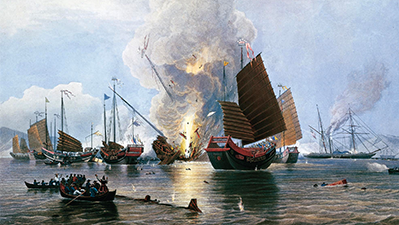State Expansion from 1750 to 1900 CE
Teacher Resources
Driving Question: How did industrialization shape the expansion and administration of empires from 1750 to 1900?
As imperialist powers expanded their reach, they did so in different ways. Regardless of the methods involved, state expansion would have many intended and unintended consequences around the globe.
Learning Objectives:
- Compare processes by which state power shifted in various parts of the world from 1750 to 1900.
- Evaluate the various tools used by imperial powers to expand their empires and the environmental and economic causes of these expansions.
- Use image analysis skills to determine the message and meaning of imperialism through illustrations from the late nineteenth and early twentieth centuries.
Vocab Terms:
- activist
- administrator
- bureaucracy
- diplomacy
- indirect rule
- profit
- sovereignty
Opener: State Expansion
To teach this lesson step, refer to page 3 of the Lesson 6.2 Teaching Guide.
Help students decode visuals with Three-Step Reading: first the big picture, then the details, then the meaning. Check out page 3 of our Reading Guide for more.
A picture really can tell a thousand words! Reinforce your understanding of imperialism through an analysis of an illustration. At the end of this lesson, you’ll continue this practice with more image analysis.
Gentlemen of the Jungle
To teach this lesson step, refer to page 3 of the Lesson 6.2 Teaching Guide.
This activity may need to be modified, adapted, or differentiated for your students. Learn more in the OER Project Differentiation Guide.
It’s a jungle out there—and in here, where you will be analyzing a fable that might tell us a thing or two about colonialism.
Tools of Imperialism
To teach this lesson step, refer to page 6 of the Lesson 6.2 Teaching Guide.
When remodeling or reshaping something, one needs the right tools to get the job done. What kind of tools allowed imperialism to reshape the world?
-
Guiding Questions
-
Before you read
Preview the questions below, and then skim the article. Be sure to look at the section headings and any images.
While you read
Look for answers to these questions:
- How are colonialism and imperialism different?
- What were some ways of thinking about the world that supported imperialism?
- What physical tools helped imperial powers to create empires?
- What is gunboat diplomacy?
- How did science sometimes function as a tool of imperialism?
- What is indirect rule?
After you read
Respond to the following questions:
- To what extent does this article explain how various technological factors contributed to the expansion of empires from 1750 to 1900?
- The tools of imperialism were being developed at the same time as other transformations were reshaping the world. What are some connections you see between these tools and transformations like industrialization, the rise of capitalism, reformism, and liberal and nationalist political revolutions?
Closer: State Expansion
To teach this lesson step, refer to page 7 of the Lesson 6.2 Teaching Guide.
Imperialism Cartoons can be a very fun class activity. Read more in this thread in the Community Forum
As you did earlier in this lesson, use your image analysis skills to find the meaning behind cartoons created during this period of imperial expansion.




